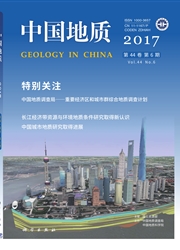

 中文摘要:
中文摘要:
白鑫滩铜镍矿床位于觉罗塔格构造岩浆带内,岩体走向受大草滩断裂控制,目前矿床规模达中型。含矿岩体侵入于中奥陶统恰干布拉克组,直接围岩为英安岩和火山角砾凝灰岩,主要岩石类型为辉长岩、橄榄辉石岩和辉石橄榄岩,岩石由中心向两侧基性程度逐渐降低,岩体产状平缓,主要赋矿岩相为辉石橄榄岩相,矿体多呈似层状或透镜状。含长辉石橄榄岩中锆石La-ICP-MS U-Pb定年结果为(277.9±2.6)Ma,表明岩体形成于早二叠纪。以24号勘探线为界,岩体西段矿石Cu/Ni比值普遍高于岩体东段矿石。样品中Mg O与Fe OT呈正相关关系,与Ca O、Si O2和Ti O2呈负相关关系,样品m/f值为2.43~3.9,为铁质系列超镁铁岩,有利于铜镍矿的形成;样品稀土元素配分型式为轻稀土略富集的右倾型,轻、重稀土元素之间分馏程度较弱,具有弱的负Eu异常;富集大离子亲石元素,而相对亏损高场强元素,有明显的Nb、Ta负异常。岩浆演化过程中主要发生了橄榄石和辉石的分离结晶/堆晶作用,并遭受了少量中—下地壳物质混染,岩浆源区遭受了明显的俯冲流体交代作用。白鑫滩矿床形成时代及构造背景与黄山东、黄山、香山等典型矿床一致,是图拉尔根—黄山东—土墩铜镍矿带的西延部分,该铜镍矿带向西仍有较大的铜镍找矿潜力,大草滩断裂可能也是该区重要的控岩控矿断裂。
 英文摘要:
英文摘要:
The medium-sized Baixintan Ni-Cu deposit is located at northern Dacaotan fracture, Eastern Tianshan Mountains. The intrusion is emplaced in middle Ordovician Qiaganbulake Group, and the direct country rocks are dacite and tuff. The Baixintan deposit mainly consists of gabbro, olivine pyroxenite and wehrlite, with wehrlite being the main ore-bearing rock type. Orebodies are mostly in bedded or lenticular form. From the center outwards the basicity shows a decreasing trend. Zircon U-Pb La-ICP-MS age of plagioclase-bearing wehrlite is(277.9±2.6) Ma, suggesting Early Permian. With No. 24 exploration line as the dividing line,the Cu/Ni ratio of western orebody is higer than that of the eastern orebody. The values of Mg O and Fe OTshow positive correlation,and there is a negative relationship between Mg O and Si O2, Ca O and Ti O2. The m/f ratio is between 2.43 and 3.9, belonging to the iron series ultramafic rocks. Chondrite-normalized REE patterns show LREE enrichment and negative or no Eu anomaly. The rocks are enriched in LILE and depleted in HFSE(Nb, Ta). The fractionation crystallization/cumulation was dominated by olivine and pyroxenes in the process of magmatic evolution. The geochemical features of analyzed rocks indicate that the parental magma of the rocks experienced weak contamination by middle- lower crust components during its upward migration. The magma source was metasomatized by subduction fluid. The chronological and geochemical characteristics, together with regional evolution history of Earsten Tianshan area, indicate that the Baixintan Cu-Ni deposit might be the product of post-collision extension and mantle plume activities. There is still huge potential for Cu-Ni mineralization on the weatern side of the Huangshandong-Jingerquan-Tulargen Cu-Ni ore belt. The Dacaotan fracture may be another main structure which controls the mafic intrusion and the Ni-Cu deposit.
 同期刊论文项目
同期刊论文项目
 同项目期刊论文
同项目期刊论文
 期刊信息
期刊信息
